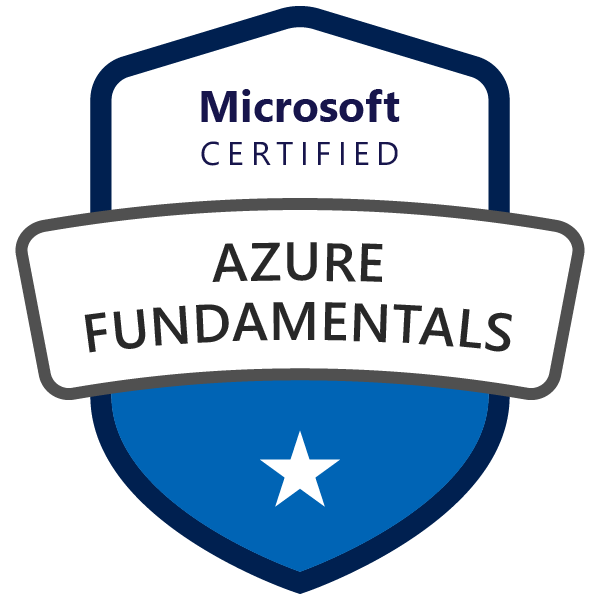My Summer Romance With the Cloud (and Why I’m Hooked)
Let’s rewind a few months.
It’s midsummer, the sun is shining (well, shining sometimes, because let’s be honest, clouds are involved in this story in more ways than one), and I’m scrolling through my never-ending “things to learn” list. Somewhere between “learn to bake sourdough” and “finally finish that Python side project” sits a thought I’ve been dancing around for a while: cloud computing.
Now, I’ve always been vaguely aware of the cloud. Not the clouds up in the sky — although they’re nice too — but the mystical, invisible place where our photos, files, and streaming services live. But until recently, I hadn’t truly peeked under the hood to see what was going on in there.
This summer, I decided to change that.
Why the Cloud?
Before we get to the juicy part (my journey with the AZ-900), let’s start with the basics: why even bother learning about the cloud?
Here’s the short answer:
The cloud is everywhere. And I mean everywhere. That video you watched this morning? Cloud. The AI tool you used to generate a meme? Cloud. The cat pictures you forgot you saved three years ago? Cloud.
The long answer?
Cloud computing is essentially renting someone else’s giant, super-secure, high-powered computer to do your work for you. Instead of buying your own massive servers and locking them in a basement (plus worrying about electricity, cooling, and that one colleague who always trips over cables), you just “rent” computing power, storage, databases, and other services from a provider — on demand, and you pay only for what you use.
Sounds magical? It kind of is.

Picking My Cloud Crush
When you start reading about cloud computing, three names keep popping up like persistent pop-up ads:
Amazon Web Services (AWS) – The veteran, the giant, the “we’ve been here since before you were even thinking about the cloud” kind of player.
Google Cloud Platform (GCP) – The cool, data-driven kid in the group, with strong analytics, machine learning chops, and… Kubernetes (which they basically invented).
Microsoft Azure – The friendly neighbor who already knows your Windows setup, offers you free cookies, and says “don’t worry, we’ll integrate everything nicely.”
I started reading more about all three, and it was fascinating to see that while the architectures, branding, and dashboards differ, the core services are almost always the same:
Compute – Running applications, virtual machines, and containers.
Storage – Saving your files, backups, and Big Data.
Networking – Moving your data from point A to point B without the internet equivalent of traffic jams.
Databases – From SQL to NoSQL to “I don’t know what this is but it stores my data.”
Machine Learning & AI tools – Because who doesn’t want to train their own chatbot these days?
It’s like pizza: different restaurants, different toppings, but dough, sauce, and cheese are always there.
The Big Decision: AZ-900
After reading articles, watching YouTube videos, and lurking in a few tech forums, I realized something: I could read about the cloud forever and still feel like I hadn’t started. I needed a goal. Something structured. Something with a badge at the end.
That’s when I found the AZ-900: Microsoft Azure Fundamentals certification.
The AZ-900 is basically the “Cloud 101” of Azure — no need to be a hardcore sysadmin or a programming wizard. It’s for people who want to understand what Azure offers, how cloud concepts work, and how to explain them without sounding like they just read the Wikipedia page five minutes ago.
So I signed up.
Studying for AZ-900: The Good, the Bad, and the Confusing
Now, here’s where things get interesting.
I thought to myself: “Fundamentals? How hard can this be?”
Spoiler: harder than I thought.
Don’t get me wrong — the content is super interesting. You learn about:
Shared responsibility models (a fancy way of saying “you handle your stuff, the cloud handles theirs”).
Pricing models (pay-as-you-go, reserved instances, and the mythical free tier).
Security basics (yes, your cat photo archive is safe… probably).
Regions and availability zones (translation: your data lives in multiple secret bunkers around the world).
But even though the AZ-900 doesn’t dive into hardcore coding or infrastructure setup, there’s a lot of terminology. And cloud terminology loves its acronyms. By day two, my notes looked like a bowl of alphabet soup: IaaS, PaaS, SaaS, VM, VNet, NSG, MFA…
The One-Week…
I decided to go all in and study for one full week.
Every morning, coffee in hand, I’d fire up Microsoft Learn, watch tutorials, read docs, and do practice quizzes. In the evenings, I’d try to explain concepts to my friends who would politely nod while wondering why I suddenly cared about “geo-redundancy” and “compliance certifications.”
There were moments when I thought my brain was going to explode from information overload. But there were also “aha!” moments — the ones where I could suddenly connect the dots between different cloud services and see the bigger picture.
Machine Learning & AI in the Cloud: Where the Magic Happens
One of the most exciting parts of exploring the cloud was realizing just how much it’s used in AI and machine learning.
All three big providers — AWS, Azure, and Google Cloud — offer platforms for:
Training models on massive datasets without needing a supercomputer at home.
Deploying AI services like image recognition, speech-to-text, and translation.
Building chatbots that can actually hold a conversation (or at least pretend convincingly for a few minutes).
Here’s what this looks like in real life:
AWS SageMaker lets you spin up an environment to train and deploy ML models in minutes.
Google Vertex AI integrates beautifully with their BigQuery and TensorFlow ecosystem.
Azure Machine Learning gives you a low-code or code-first way to train models, plus pipelines to deploy them straight to production.
Even cooler? Many of these services have pre-trained models. So if you want to build an app that can recognize whether your dog is happy, sad, or plotting to steal your sandwich, you don’t have to train it from scratch — just call an API and you’re done.

The Exam Day
Exam day arrived, and I was equal parts nervous and caffeinated.
The test itself wasn’t as terrifying as I feared — lots of multiple-choice questions, some scenarios, and a few “drag the right service to the right description” tasks.
Some questions I knew instantly. Others made me second-guess myself (“Wait, is Blob Storage for unstructured data or… structured? Or was that Files?”).
When I clicked “Submit” and saw the Congratulations screen, I may or may not have fist-pumped the air like I’d just won the cloud lottery.
So, what’s next?
First of all, I’m definitely not done with cloud learning. I might not stick only to Azure — I’m curious about AWS certifications, and Google Cloud’s data services have been calling my name.
The great thing is, once you understand the fundamentals with one provider, jumping to another isn’t as daunting. Sure, the names change (what Azure calls a “Resource Group,” AWS might just call part of your infrastructure setup), but the core concepts remain the same:
Compute
Storage
Networking
Databases
AI/ML services
It’s like learning to drive — once you’ve mastered one car, switching to another model just means figuring out where they’ve hidden the windshield wiper button.
Final Thoughts: Why You Should Dive Into the Cloud
If you’ve been thinking about getting into cloud computing, my advice is: do it.
Not just because it’s a booming field with job opportunities galore (though that’s true), but because it’s genuinely fascinating to see how all these pieces fit together.
Plus, there’s a certain joy in realizing you can spin up a virtual machine in seconds, train an AI model, store terabytes of data, and connect it all to an app — all without leaving your laptop. And if you’re like me, you might just find yourself talking about “latency” and “service level agreements” over coffee like it’s the most natural thing in the world.
Whether you choose Azure, AWS, or Google Cloud, the fundamentals are the same. The names change, but the magic doesn’t.

